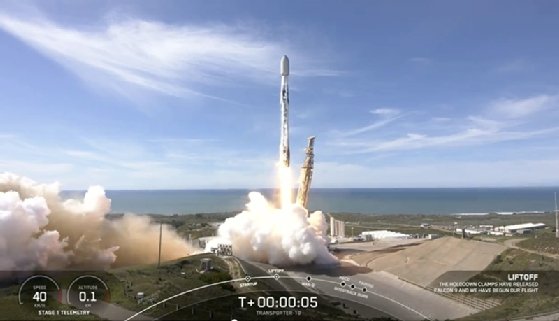
Pickup - stock.adobe.com
Open Cosmos and Ubotica report success in satcoms launch
Space technology and data company launches first satellite of the year aiming to provide hyperspectral artificial intelligence data for marine monitoring and emergency responses across the Atlantic
After a lift-off from Vandenberg Space Force Base in California onboard SpaceX’s Falcon 9 as part of the Transporter 10 mission, Open Cosmos has announced the successful launch of its latest Earth observation satellite, Hammer, which is carrying CogniSAT-6 for Ubotica, a provider of autonomous SPACE:AI-enabled satellite technology.
Hammer (hyperspectral artificial intelligence for marine monitoring and emergency response) is an in-orbit demonstration (IOD) satellite that will host a miniaturised Earth observation payload alongside integrated onboard processing capabilities, developed by Ubotica Technologies.
The satellite was designed, built and tested by Open Cosmos at its facilities in Harwell, UK, using the in-orbit demonstration programme of the Satellite Applications Catapult – a programme designed to drive take-up of space technology and applications – that provides technical, quality and programmatic support and access to specialist facilities.
Following launch, Open Cosmos received confirmation of the successful deployment of Hammer from the Exolaunch deployer during the first pass and, shortly afterwards, satellite operators at the Open Cosmos Control Centre received a strong signal from the satellite and started downloading telemetry nominally.
In operation, Hammer is intended to acquire, process, compress, store and forward medium-resolution hyperspectral imagery for Atlantic coastal and high seas areas. Alongside this, Hammer will give a quick and effective response to natural disasters due to its compatibility and interoperability with existing Earth observation networks, enabling collaboration with other satellites and ground-based systems for comprehensive monitoring and emergency response.
The satellite boasts a hyperspectral camera, capable of delivering unparalleled resolution and clarity for Earth observation. Hyperspectral imaging captures images across hundreds of narrow spectral bands, offering detailed information about the composition of objects or scenes. By analysing the unique spectral signatures of materials, hyperspectral imaging enables applications in agriculture and environmental monitoring, among others.
The integration of artificial intelligence (AI) boards in Hammer is designed to enable real-time, onboard data analysis, enhancing responsiveness to dynamic environmental changes without ground station transmission and human intervention. This is said to boost efficiency, optimise resource use and enhance intelligence for disaster response, agriculture and urban planning. Additionally, it is also attributed with increasing autonomy for immediate decision-making in emergencies.

Inter-satellite linking is intended to ensure continuous data transmission for global coverage. It also reduces latency and increases data throughput, which is crucial for real-time applications, according to Open Cosmos. Additionally, inter-satellite linking is also said to provide flexibility, security and cost-effectiveness, allowing integration and efficient operations within satellite constellations.
Hammer is the latest addition to the OpenConstellation. Open Cosmos’s mutualised satellite infrastructure. This aims to facilitate shared access to satellite data, reducing costs and increasing data quality and frequency, allowing partners to benefit from broader global coverage and more frequent revisit times.
Commenting on the successful launch, Open Cosmos mission manager Oriol Aragon Casaled said: “Hammer truly is a game changer for Open Cosmos and a satellite that is sure to disrupt the market. The inclusion of a hyperspectral camera and AI board ensures the most advanced imaging in the market, while the inter-satellite linking makes data available in almost real time. This means our customers don’t have to wait days, or even hours, for insights from their areas of interest – they can get them in minutes. For us, Hammer is setting a new standard for Earth observation satellites.”
Ubotica believes that CogniSAT-6 will no less than revolutionise Earth observation, providing actionable live Earth intelligence for real-time decision-making. The mission uses Ubotica’s partnership with Open Cosmos, which designed and built the Hammer satellite. The CogniSAT-6 mission with the Hammer satellite combines onboard AI with live communications to stream live Earth intelligence directly to users. This capability is said to empower immediate analysis and action across various industries.
“Just as AI transforms life on Earth, SPACE:AI will revolutionise how we understand Earth in real time,” said Ubotica CEO Fintan Buckley. “CogniSAT-6 empowers users with live Earth intelligence, transforming how we interact with our planet. It combines onboard AI, real-time satellite communication and adaptable observation strategies for immediate, actionable insights.”
Read more about satellite communications
- Speedcast on board with connectivity for P&O maritime logistics: Comms and IT services provider sets sail to deliver multi-orbit, multi-path SD-WAN service across 59 vessels in fleet of provider of critical logistics support and marine offerings for offshore energy, port services and cargo transportation.
- Meteoric growth in VSAT, BGAN, SatPhones and 5G mobile devices: Research finds rapid deployment of non-geostationary orbit networks such as Starlink, Eutelsat OneWeb, and soon Amazon’s Kuiper, quickly advancing innovation in the satellite ground segment.
- Hispasat launches projects to drive satellite integration in 5G, 6G development: Iberian and Latin American satellite operator announces three programmes designed to facilitate the standardisation of space communications usage and enable 5G, and potentially 6G, to have universal deployment.
- CGI, Eutelsat OneWeb, Icomera pilot satellite broadband for UK trains: IT and business consulting services reveal live trials to demonstrate how integrated low-earth orbit satellite and terrestrial communications networks can provide seamless, low latency broadband connectivity on Britain’s rail network.









